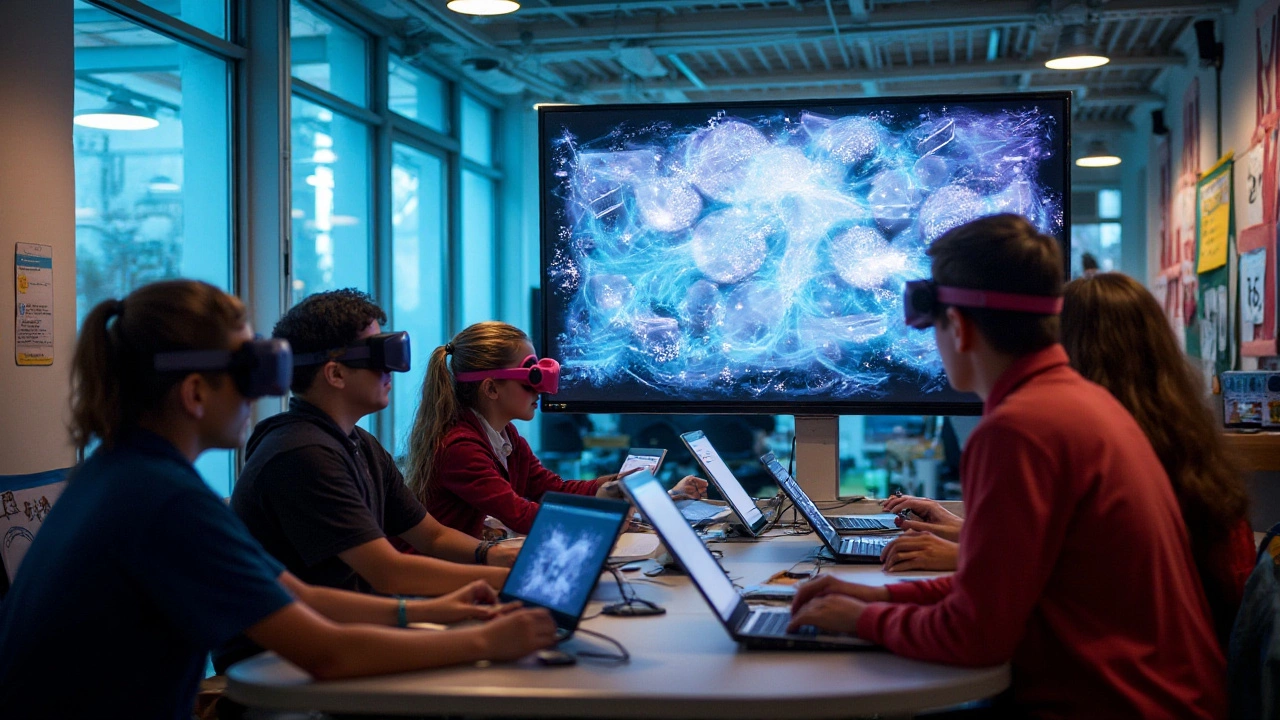In a world that's more interconnected than ever, the way we learn has evolved significantly. Distance learning, often synonymous with remote education, has carved its own niche in the realm of academics. But what exactly does it entail, and why has it become a buzzword in recent years?
Imagine a classroom without walls, where learning transcends the traditional boundaries of a physical setting. Distance learning allows students to engage with educational content and instructors from virtually anywhere. It offers unprecedented flexibility, making education more accessible and personalized. As we delve deeper, we'll explore how this transformative mode of learning works, its benefits, and a few tips to navigate the virtual classroom successfully.
- Defining Distance Learning
- The Evolution of Remote Education
- Benefits and Challenges of Virtual Learning
- Tips for Success in Online Classes
Defining Distance Learning
Distance learning, a term that has become quite familiar in recent years, refers to an educational approach that allows students and instructors to engage remotely. It breaks free from the constraints of a traditional classroom by leveraging technology to deliver educational experiences. While distance learning isn’t entirely new, dating back to correspondence courses through mail, modern advances have transformed it significantly. Now, it thrives on the internet, offering a plethora of options for learners worldwide.
One of the key aspects of distance learning is its flexibility, accommodating students who possess varying schedules and commitments. This flexibility means learners can access course materials amidst their busy lives, fitting in study sessions between work hours or family responsibilities. In traditional educational setups, students are required to be physically present, but with distance learning, one can attend classes from the comfort of their own home, lounging in pajamas, sipping a cup of tea.
Distance learning relies heavily on technology, encompassing tools such as video conferencing, online forums, and virtual simulations. This tech-driven approach fosters a unique kind of engagement, allowing learners from diverse backgrounds to collaborate and share insights. A significant component of this remote form of learning is the online platform where course content, discussions, and assessments take place. These platforms aim to simulate the classroom environment as closely as possible, but it also empowers students with new ways to learn and interact.
In discussing the impact of remote education, former U.S. Secretary of Education Arne Duncan once said,
"Technology in education is not a silver bullet, but it is a powerful force that can open up new methods of learning we've never before seen."This sentiment underscores the transformative potential of distance learning, emphasizing its role in education reform. Importantly, it also points out the challenges faced, such as the digital divide affecting students' ability to access online resources globally.
Another cornerstone of distance learning is its progressive methodologies in teaching, which range from asynchronous approaches—where students study on their own time—to synchronous ones—replicating scheduled class times online. This blend of methods allows educators to tailor instruction, catering to various learning styles and ensuring comprehensive knowledge dissemination. Virtual learning scripts a new narrative where students often emerge as self-starters, responsible for pace and productivity while pursuing academia.
To put it succinctly, distance learning is a dynamic and evolving field, making education more inclusive than ever. As it continues to evolve, with more institutions adopting hybrid models of learning that combine online and in-person teaching, understanding distance education is crucial for any learner in the digital age.

The Evolution of Remote Education
Remote education, often referred to as distance learning, has undergone a remarkable transformation over the years. Initially, it began as correspondence courses in the 19th century, where students would receive lessons via mail. These courses allowed individuals in remote areas access to education, breaking the monotony of traditional, location-based learning methods. With roots in such modest beginnings, distance learning has continuously adapted and evolved with technological advancements, resulting in the growing popularity it enjoys today.
The advent of the internet was a significant turning point for remote education. By the late 20th century, online classes became a viable option for many. Educational institutions began offering courses on their websites, enabling students to receive instruction and submit assignments digitally. This revolutionized how students interacted with faculty and curriculum, offering a level of immediacy and interactivity that postal correspondence simply could not match. Yet, as with any transformation, this era of online classes came with its share of challenges and growing pains, such as ensuring reliable internet access and developing a user-friendly interface.
One of the notable milestones in the evolution of remote education was the launch of platforms like Moodle and Blackboard in the early 2000s. These learning management systems allowed institutions to offer a structured and comprehensive online learning experience. They included features like discussion forums, quizzes, and multimedia materials, enhancing the interactive aspect of online classes. As technology advanced, so did the sophistication of these platforms, eventually integrating tools like video conferencing and real-time feedback to increase engagement and interaction.
The Digital Revolution
The digital revolution of the past decade has further accelerated the progress of virtual learning environments. Smartphones, tablets, and cloud-based services have made learning more accessible and flexible than ever before. Now, students can carry an entire library in their pockets, access coursework from anywhere in the world, and collaborate with peers across the globe seamlessly. This level of global connectivity has fostered diverse learning opportunities that were previously unimaginable, allowing for educational programs that combine the best of different teaching methodologies and perspectives.
"The measure of intelligence is the ability to change." – Albert Einstein
Recent years have seen the rise of massive open online courses (MOOCs), which democratize education by offering free or low-cost courses from prestigious institutions to anyone with internet access. Platforms like Coursera, Udacity, and edX are at the forefront of this movement, providing opportunities for people to upskill or pursue personal interests without the constraints of a traditional classroom. The shift towards remote education has undoubtedly opened doors for many, proving that the quest for knowledge need not be confined to a single path or format.

Benefits and Challenges of Virtual Learning
Dive into the world of virtual learning, and you'll discover a prominent landscape woven with endless possibilities and hurdles alike. One of the most profound benefits that comes with distance learning is its remarkable flexibility. Students have the liberty to learn at their own pace, balancing studies between work or family life with far greater ease than traditional settings afford. An early bird might tackle lessons with the fresh dawn, while a night owl might prefer diving into coursework under the quiet watch of the stars. This adaptability reshapes education into something far more accommodating, catering to various schedules and commitments.
However, this new educational freedom can also morph into a challenge; without the disciplined scaffold of regular classrooms, some learners find it harder to thrive. The whispers of procrastination often grow louder, tempting with distractions that derail focus and productivity. Traditional classrooms instinctively foster accountability – you're physically present, engaging with peers and mentors, bolstering motivation through sheer human presence. Replicating this connection through screens demands more intrinsic drive and innovative technology to simulate that authentic sense of community. According to Professor Matthew Lynch, "Designing a digital space that keeps students engaged and motivated mirrors the art of crafting a compelling narrative – it must hold both relevance and intrigue to captivate.”
The potential barriers with technology cannot be overlooked, especially in regions where internet access or reliable devices remain luxuries rather than givens. This disparity reinforces educational inequities, a far-reaching challenge we must acknowledge and address. On the upside, when technology cooperates, online classes unravel a tapestry of resources previously unimaginable. Interactive platforms, stimulating multimedia content, discussion forums, and collaborative projects enhance the learning experience. Students and teachers, often oceans apart, find themselves collaborating, fostering a global exchange of ideas and cultures right within the virtual classroom. The benefits here extend beyond academia, for these connections lay the foundation for a more interconnected and empathetic world community.
Living in a digital age, where the rapid advance of tools and platforms ceaselessly rewrites the manual, educators and students alike must evolve alongside. Embracing digital literacy becomes crucial, as more academic institutions continue to integrate extensive virtual components into their curriculums. As learners become adept at navigating the digital landscape, they build skills undeniably essential in today's job market, making virtual learning not only an avenue for acquiring knowledge but also for securing proficiency in technology-driven environments. Still, the shadow of cognitive overload looms. With abundant resources at one's fingertips, students might find themselves overwhelmed, their attention divided between countless tabs, notifications incessantly tugging at their focus.
To thrive in remote education, it becomes paramount to cultivate a sense of balance and discipline. Students should establish dedicated learning spaces and structured routines, setting clear goals and priorities for each session. By doing so, they can forge a pathway that optimizes the joys of virtual learning while mitigating its potential pitfalls. Remarkably, the tug-of-war between benefits and challenges of virtual learning mirrors the essence of life itself, teaching us lessons far beyond the textbook pages.

Tips for Success in Online Classes
Navigating the world of distance learning can feel like embarking on a new adventure. However, it's an adventure that comes with its own set of challenges and requires certain strategies to thrive. The beauty of remote education is that it gives you the freedom to learn in your way, but with that freedom comes the responsibility of self-discipline and time management.
First and foremost, setting a dedicated study space is crucial. Your brain will associate this space with being in "school mode" and help improve focus. Make sure this space is free from distractions, and equip it with all the essentials you need to attend your online classes. A clutter-free and quiet environment helps concentrate better and brings a semblance of a classroom into your home.
Creating a schedule is another vital step. With the flexibility of virtual learning, one might be tempted to put off study sessions. But sticking to a timetable ensures consistency in your study habits. It’s a good idea to map out your day or week, allocating specific time slots for different subjects or topics. Many learners find using digital calendars or planner apps beneficial to keep track of classes and deadlines.
"The art of learning is the art of attention—what we focus on grows stronger within us," says John Green, renowned author and educator. His words remind us of the importance of focus in the learning process.
Active participation is another key factor for success. Unlike in traditional teaching, where interaction is sometimes one-sided, virtual learning thrives on student participation. Engage with your instructors and peers during discussions or forums. This not only enhances your understanding but also makes the learning experience enjoyable. Collaboration tools and discussion boards are useful for sharing ideas, asking questions, and even networking with fellow students.
Technology is the vehicle driving this mode of education, and being tech-savvy is no longer optional. Familiarize yourself with the digital platforms and tools your course requires. Whether it’s a Learning Management System, video conferencing software, or online libraries, knowing how to use them efficiently can minimize tech-related stress. It’s worth checking if your institution offers tutorials or resources to get you started.
Another crucial aspect is taking regular breaks. Cognitive science suggests the brain processes information better when given time to rest. Incorporate short breaks into your study sessions to stretch, relax, or hydrate. This practice can reduce stress and stave off burnout while improving concentration when you return to your studies.
Lastly, never hesitate to seek help when needed. Many online education platforms provide resources such as access to tutors, academic counseling, or technical support. Reaching out not only solves your current problem but also enriches your learning experience, ensuring you’re making the most of your online classes. Remember, successful learners are not those who never encounter difficulties, but those who respond to challenges proactive.
| Key Strategies | Benefits |
|---|---|
| Dedicated study space | Improves focus |
| Creating a schedule | Ensures consistency |
| Active participation | Enhances understanding |
| Staying tech-savvy | Reduces tech-related stress |






